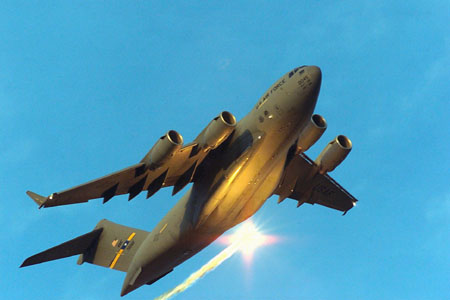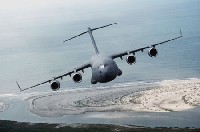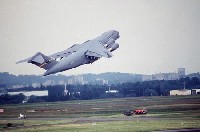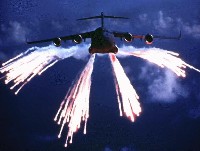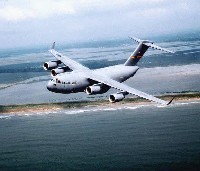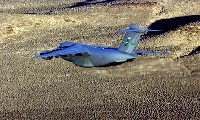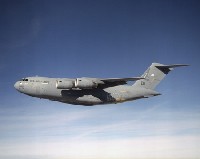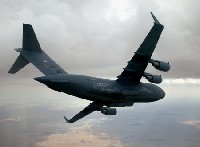|
Global Aircraft -- C-17 Globemaster III
Aviation Center
US Attack
US Bombers
US Cargo
US Fighters
US Helicopters
US Patrol/Pursuit
US Reconnaissance
US Tankers
US Trainers
US UAV's
US X Planes
Orbiter Vehicles
WWI Aircraft
WWII Aircraft
Airbus
Antonov
Boeing
Dassault
Ilyushin
Kamov
MiG
Mil
Saab
Sukhoi
Tupolev
Yakovlev
Joint/Rest of World
Entertainment Center
Members Center
New Technologies
Contact Us
Extra Navigation
GAC Engine
C-17 Globemaster III Specifications
C-17 Globemaster III Achievements
C-17 Globemaster III Features
Reliability and maintainability are two outstanding benefits of the C-17 system. Current operational requirements impose demanding reliability and maintainability. These requirements include an aircraft mission completion success probability rate of 92 percent, only 20 aircraft maintenance man-hours per flying hour, and full and partial mission availability rates of 74.7 and 82.5 percent, respectively. The Boeing warranty assures these figures will be met. The C-17 measures 174 feet long (53 meters) with a wingspan of 169 feet, 10 inches (51.75 meters). The aircraft is powered by four, fully reversible, Federal Aviation Administration-certified F117-PW-100 engines (the military designation for the commercial Pratt & Whitney PW2040), currently used on the Boeing 757. Each engine is rated at 40,440 pounds of thrust. The thrust reversers direct the flow of air upward and forward to avoid ingestion of dust and debris. Maximum use has been made of off-the-shelf and commercial equipment, including Air Force-standardized avionics. The aircraft is operated by a crew of three (pilot, copilot and loadmaster), reducing manpower requirements, risk exposure and long-term operating costs. Cargo is loaded onto the C-17 through a large aft door that accommodates military vehicles and palletized cargo. The C-17 can carry virtually all of the Army's air-transportable equipment. Maximum payload capacity of the C-17 is 170,900 pounds (77,519 kilograms), and its maximum gross takeoff weight is 585,000 pounds (265,352 kilograms). With a payload of 160,000 pounds (72,575 kilograms) and an initial cruise altitude of 28,000 feet (8,534 meters), the C-17 has an unrefueled range of approximately 2,400 nautical miles. Its cruise speed is approximately 450 knots (.74 Mach). The C-17 is designed to airdrop 102 paratroopers and equipment. The design of the aircraft allows it to operate through small, austere airfields. The C-17 can take off and land on runways as short as 3,000 feet (914 meters) and only 90 feet wide (27.4 meters). Even on such narrow runways, the C-17 can turn around using a three-point star turn and its backing capability. Source: http://www.af.mil
C-17 Globemaster III Background
The McDonnell Douglas (now owned by Boeing) C-17 was designed to fulfill airlift needs well into the new century. Boeing is on contract with the Air Force to build and deliver 120 C-17s through 2004. The Air Force declared the first C-17 squadron operational in January 1995. Since then the fleet has amassed more than 200,000 flying hours. In 1998, eight C-17s completed the longest airdrop mission in history, flying more than 8,000 nautical miles from the United States to Central Asia, dropping troops and equipment after more than 19 hours in the air. In February 1999, President Bill Clinton presented the Malcolm Baldrige National Quality Award for business excellence to Boeing Airlift and Tanker Programs, maker of the C-17. In May 1995, the C-17 received the prestigious Collier Trophy, symbolizing the top aeronautical achievement of 1994. During normal testing, C-17s set 22 world records, including payload to altitude time-to-climb and the short takeoff and landing mark, in which the C-17 took off in less than 1,400 feet, carried a payload of 44,000 pounds to altitude, and landed in less than 1,400 feet. Summary Copyright © Charles M (JetWhiz) | ||||||||||||||||||||||||||||||||||||||
